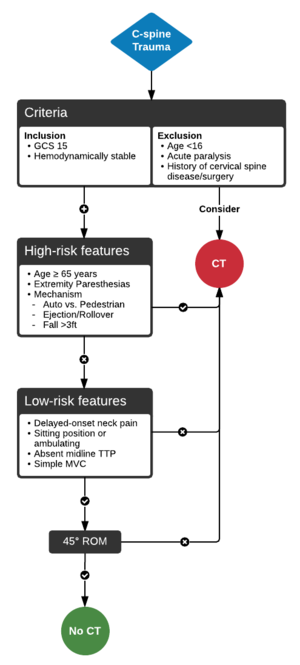We need you! Join our contributor community and become a WikEM editor through our open and transparent promotion process.
Cervical spine clearance
From WikEM
Contents
Background
- US and Canada with more than 13 million trauma patients per year at risk for C-spine injury
- Most blunt trauma patients will be placed in a cervical collar by EMS to protect the C-spine
- C-spine can be clinically cleared by trained personnel
Clinical Features
C-spine injuries may present with
- Rarely neurogenic shock (bradycardia, hypotension)
- Posterior neck pain
- Pain on palpation of spinous processes
- Limited neck ROM with pain
- Weakness, numbness, or paresthesias
Decision Rules
NEXUS Cervical Spine Rule
Radiography is not necessary if the patient satisfies ALL of the following low risk criteria:
- No midline cervical tenderness
- No focal neuro deficits
- Normal alertness
- No intoxication
- No painful distracting injury
C-spine imaging should be considered unless the patient meets all of the above low risk criteria[1] [2]
Canadian Cervical Spine Rule
No High Risk Factors
- Age >65
- Dangerous mechanism
- Parasthesias in extremities
ANY Low Risk Factor
- Simple rear end MVC
- Delayed onset of pain
- Sitting position in ED
- Ambulatory at any time
- Absence of midline C-spine tenderness
ROM
- Rotates neck 45 degrees to left and right
C-spine can be cleared clinically if above criteria met[3] [4]
Canadian rule vs. Nexus
A single trial showed Canadian rule would pick up 312 or 313 clinically important cases, while NEXUS would miss 1 one in 10 cases[5]
Sensitivity
Canadian 99.4% vs Nexus 90.7%
Specificity
Canadian 45.1% vs. Nexus 36.8%
Management
Criteria Met
- If CCSR or NEXUS criteria is met, patient can be cleared clinically
Criteria Not Met
- If unable to be cleared by CCSR or NEXUS then imaging is indicated with CT C-spine is indicated
- CT recommended over xray
- For significant injury CT has a sensitivity of 100% while xray has a sensitivity 36%[6]
- CTs/Xrays not adequate to assess for ligamentous instability
- If patient continues to have midline pain after adequate pain control obtain MRI (potentially as outpatient)
- Keep C-collar until MRI results or pain resolves
Obtunded Patient
- C-Spine management unclear in the obtunded adult patient with blunt trauma after negative CT C-spine
- EAST (Eastern Association for the Surgery of Trauma) performed systematic review in 2015[7]
- Review included 1800 obtunded patients generally defined as GCS<13 with negative CT c-spine using <3mm axial cuts
- Of 1800 patients, 176 patients with abnormal MRI
- None (or 0/176) had unstable C-spine injury
- EAST guideline notes: We conditionally recommend cervical collar removal after a negative high-quality C-spine CT scan result alone[8]
Disposition
- Based on imaging results
See Also
- Blunt neck trauma
- Canadian cervical spine rule
- EBQ:Canadian C-spine Rule Study
- NEXUS cervical spine rule
- EBQ:NEXUS
- C-Spine X-Ray
External Links
References
- ↑ 27. Hoffman JR, et al. Low-risk criteria for cervical-spine radiography in blunt trauma: a prospective study. Ann Emerg Med 1992;21:1454-60.
- ↑ Mahadevan, et al. Interrater reliability of cervical spine injury criteria inpatients with blunt trauma. Ann Emerg Med1998;31:197-201
- ↑ Stiell IG,et al. The Canadian C-spine rule for radiography in alert and stable trauma patients. JAMA. 2001 Oct 17;286(15):1841-8. EBQ:Canadian C-spine Rule Study
- ↑ Stiell IG, et al. The Canadian C-spine rule versus the NEXUS low-risk criteria in patients with trauma. N Engl J Med. 2003;349(26):2510-8.
- ↑ Stiell IG, Clement CM, and McKnight DR, et al. The Canadian c-spine rule versus the NEXUS low-risk criteria in patients with trauma. NEJM. 2003; 349:2510-2518.
- ↑ Bailitz J, Starr F, Beecroft M, et al. CT should replace three view radiographs as the initial screening test in patients at high, moderate, and low risk for blunt cervical spine injury: a prospective comparison. J Trauma. 2009;66:1605e1609.
- ↑ Patel MB, et al. Cervical spine collar clearance in the obtunded adult blunt trauma patient: a systematic review and practice management guideline from the Eastern Association for the Surgery of Trauma. J Trauma Acute Care Surg. 2015 Feb;78(2):430-41
- ↑ https://www.east.org/education/practice-management-guidelines/cervical-spine-collar-clearance-in-the-obtunded-adult-blunt-trauma-patient

